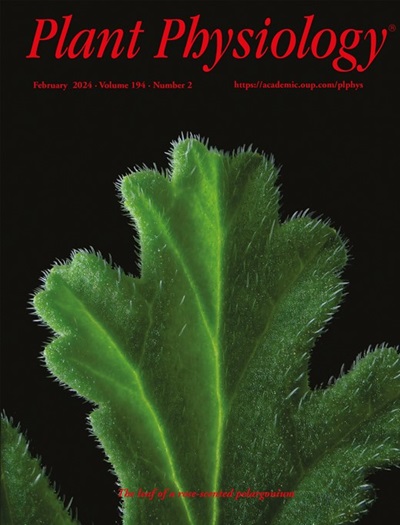Molecular Insights into DNA Recognition by HD-Zip Transcription Factors
IF 6.9
1区 生物学
Q1 PLANT SCIENCES
引用次数: 0
Abstract
Homeodomain–leucine zipper (HD-Zip) genes encode a large family of plant-specific transcription factors (TFs) that are integral to plant development, growth, regulation, and responses to environmental and hormonal signals. While the roles and mechanisms of HD-Zip TFs have been extensively studied, the structural basis for their DNA recognition remains unclear. In this study, we analyzed DAP-seq data and identified consensus DNA motifs, 5'-AAT[W]AT-3' and 5'-[N]AAA[N][N]-3', preferentially bound by HD-Zip TFs. Both motifs feature a 5'-AA(T/A)-3' core, which is shared across previously identified HD-Zip target sequences, suggesting a common recognition feature within the HD-Zip family. Focusing on the well-characterized HD-Zip IV TF PROTEIN PRODUCTION FACTOR 2 (PDF2) from Arabidopsis (Arabidopsis thaliana) and its interaction with the L1 box DNA sequence, our structural and biochemical analyses revealed that the PDF2 HD-ZA module forms a dimer to specifically recognize the 5'-AATG-3' core through an asymmetric binding mode. In this mode, only the primary recognition helix of one protomer and the N-arm of the other protomer in the PDF2 HD-ZA dimer are involved in specific DNA interactions. Our study offers insights into the molecular mechanisms of HD-Zip TFs and provides a structural template for engineering applications in agricultural research.HD-Zip转录因子对DNA识别的分子洞察
同源域-亮氨酸拉链(HD-Zip)基因编码一个大的植物特异性转录因子(TFs)家族,这些转录因子对植物的发育、生长、调节以及对环境和激素信号的反应是不可或缺的。虽然HD-Zip tf的作用和机制已被广泛研究,但其DNA识别的结构基础仍不清楚。在这项研究中,我们分析了DAP-seq数据,并确定了一致的DNA基序,5‘- aat [W]AT-3’和5'-[N]AAA[N][N]-3',优先结合HD-Zip tf。这两个基序都具有一个5‘-AA(T/ a)-3’核心,这在先前鉴定的HD-Zip靶序列中是共享的,这表明HD-Zip家族中存在一个共同的识别特征。我们的结构和生化分析表明,来自拟南芥(Arabidopsis thaliana)的HD-Zip IV TF蛋白生产因子2 (PDF2)及其与L1盒DNA序列的相互作用表明,PDF2 HD-ZA模块形成一个二聚体,通过不对称结合模式特异性识别5‘-AATG-3’核心。在这种模式下,PDF2 HD-ZA二聚体中只有一个原聚体的初级识别螺旋和另一个原聚体的n臂参与特定的DNA相互作用。我们的研究为HD-Zip TFs的分子机制提供了新的见解,并为农业研究中的工程应用提供了结构模板。
本文章由计算机程序翻译,如有差异,请以英文原文为准。
求助全文
约1分钟内获得全文
求助全文
来源期刊

Plant Physiology
生物-植物科学
CiteScore
12.20
自引率
5.40%
发文量
535
审稿时长
2.3 months
期刊介绍:
Plant Physiology® is a distinguished and highly respected journal with a rich history dating back to its establishment in 1926. It stands as a leading international publication in the field of plant biology, covering a comprehensive range of topics from the molecular and structural aspects of plant life to systems biology and ecophysiology. Recognized as the most highly cited journal in plant sciences, Plant Physiology® is a testament to its commitment to excellence and the dissemination of groundbreaking research.
As the official publication of the American Society of Plant Biologists, Plant Physiology® upholds rigorous peer-review standards, ensuring that the scientific community receives the highest quality research. The journal releases 12 issues annually, providing a steady stream of new findings and insights to its readership.
 求助内容:
求助内容: 应助结果提醒方式:
应助结果提醒方式:


